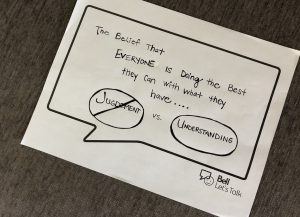Holding ourselves accountable for our actions is an essential part of our integrity.
Ensuring we are not taking on others perceived judgements is essential to our self-worth.
These two factors are easier to state than to accomplish on a daily basis but are essential to our accountability. It is hard to consistently ensure that we are taking accountability for our words and actions. It is just as hard to not take on others labels or judgments of ourselves as our reality.
How can we take steps forward in attempts to accomplish this?
1. Calling awareness to our impact:
a. What is the intention of my words or actions?
b. Was my intention accomplished?
c. Taking ownership.
2. Noticing your reactions to others impact:
a. Affirming that your value/worth is not determined by another!
b. Understanding why you are taking those labels/judgements on as your truth.
This is an ongoing assessment. It is something that you will likely have a few miss steps on—be gentle with yourself. Each moment is a fresh start.
Category Archives: Uncategorized
Self Inventory
Ensuring We are on the Right Path (or Starting a New Path if needed)
Taking a self inventory of things we are wanting out of life is a daily experience (or at least that is the goal). Pulling this process from our subconscious and calling attention to it is key.
Taking the moment to reflection upon what your day looks like at the start—
1. What expectations are before you?
2. What are you hoping for?
3. What are you going to ensure happens?
Taking an inventory throughout the day to see if you are remaining in line with how you set out that morning.
In the evening wrapping the day up with reviewing your responses to those questions from the morning.
1. Did it go as planned?
2. Did it go better?
3. Or was it different all together-creating a new path?
The process isn’t as time consuming as you may think at first glance. Its a chance to give ourselves a moment of reflection and ability to ‘check in’. Once it becomes a part of our routine it is set within our default.—We begin to do it even before the morning coffee/jolt of energy sets in.
**Key take away from this process– you have the strength to build a path and a new one at any point if that is what you’re needing**
Taking a self inventory of things we are wanting out of life is a daily experience (or at least that is the goal). Pulling this process from our subconscious and calling attention to it is key.
Taking the moment to reflection upon what your day looks like at the start—
1. What expectations are before you?
2. What are you hoping for?
3. What are you going to ensure happens?
Taking an inventory throughout the day to see if you are remaining in line with how you set out that morning.
In the evening wrapping the day up with reviewing your responses to those questions from the morning.
1. Did it go as planned?
2. Did it go better?
3. Or was it different all together-creating a new path?
The process isn’t as time consuming as you may think at first glance. Its a chance to give ourselves a moment of reflection and ability to ‘check in’. Once it becomes a part of our routine it is set within our default.—We begin to do it even before the morning coffee/jolt of energy sets in.
**Key take away from this process– you have the strength to build a path and a new one at any point if that is what you’re needing**
The Power of Our Mindset…
Our thought process is a direct reflection of our emotions and behaviour. From the moment we wake up in the morning the thoughts that are running through our mind are setting the stage for the day.
Our thought process often is in a default mode. Ex: “Ah-it’s Monday- I don’t want to go into work today.” Our emotional state and behaviours that follow are a direct representation of those initial thoughts .
How can we shift our default?
1. Acknowledgement. Notice what your thoughts are. Become intentional.
2. Actively shift your thought process. Ex: “It is Monday! Today is a fresh start. It may be challenging but I am going to learn something from this.”
3. Repeating this process will shift your mindset to being open and positive about what is to come (including the unknown).
*This process is not a simple one. It takes time, patience, and self-love (for the moments when you falter).
Our thought process often is in a default mode. Ex: “Ah-it’s Monday- I don’t want to go into work today.” Our emotional state and behaviours that follow are a direct representation of those initial thoughts .
How can we shift our default?
1. Acknowledgement. Notice what your thoughts are. Become intentional.
2. Actively shift your thought process. Ex: “It is Monday! Today is a fresh start. It may be challenging but I am going to learn something from this.”
3. Repeating this process will shift your mindset to being open and positive about what is to come (including the unknown).
*This process is not a simple one. It takes time, patience, and self-love (for the moments when you falter).
Relationship between Stress and Memory…
Moderate stress helps us recall information which is helpful when we are intentionally trying to retain information such as studying for a test. Long term stress damages our abilities to hold onto facts (both how we store this information within our brains and how we retrieve it). Reason being that stress does not help us retain information because our hormones being released by our sympathetic nervous system are causing us to react rather than respond; The notion of fight, flight, or freezing. This is where the idea of blanking on a test or blanking out memories comes to into the equation. Our brains are attempting to protect us from the stress responses.
Becoming aware of this impact for ourselves is an important first step.
When working on trying to retain information placing yourself into an environment similar to the one that you need to perform in is ideal. Exercise helps with sleep and regulation. Deep breathing exercises allows us to calm our sympathetic nervous system and resulting in lowering our stress hormones in the moment.
Surprising link between stress and memory-Elizabeth Cox (2018).
Becoming aware of this impact for ourselves is an important first step.
When working on trying to retain information placing yourself into an environment similar to the one that you need to perform in is ideal. Exercise helps with sleep and regulation. Deep breathing exercises allows us to calm our sympathetic nervous system and resulting in lowering our stress hormones in the moment.
Surprising link between stress and memory-Elizabeth Cox (2018).
Find Your Inner Gratitude
Situations that we do not plan for happen within our lives. These experiences often leave us feeling a sensation of guilt and holding negative cognitions such a: “I am not good enough, or I should have known better.” Naturally our brains are geared to land within self-critical beliefs.
We need to be cognitively aware of those beliefs and call attention to our gratitude. What is going well? What am I thankful or grateful for? Especially within this overwhelmingly negative moments. This process does not come naturally for us. We need to become aware of the negative thoughts to acknowledge them, and shift into what has this negative situation brought forward for me. In all circumstances there is a seed of positivity, growth, or something to be grateful for.
This process is a practice. Starting off by training ourselves to see the good in everyday life is a fantastic start. At the beginning of each day plant your feet on the ground when you get out of bed; and thinking to yourself of one thing you’re grateful for. This sets the tone of your day. This programs your mindset and shifts your default messages into positive ones.
What are you grateful for today?
We need to be cognitively aware of those beliefs and call attention to our gratitude. What is going well? What am I thankful or grateful for? Especially within this overwhelmingly negative moments. This process does not come naturally for us. We need to become aware of the negative thoughts to acknowledge them, and shift into what has this negative situation brought forward for me. In all circumstances there is a seed of positivity, growth, or something to be grateful for.
This process is a practice. Starting off by training ourselves to see the good in everyday life is a fantastic start. At the beginning of each day plant your feet on the ground when you get out of bed; and thinking to yourself of one thing you’re grateful for. This sets the tone of your day. This programs your mindset and shifts your default messages into positive ones.
What are you grateful for today?
Balance
We have fully transitioned into the New Year; at this point we have had three months of experience within our newly set routines. This is a helpful moment to reflect back to how we wanted this year to go. Are we following the path that we set out on? Have we taken on a new adventure? Is the direction I am headed reflect where I want to be in 6-12 months from now?
Often times we wait to reflect until the end of a goal or end of a year. Ongoing reflection helps us to maintain our goals more effectively.
Some helpful suggestions are:
a) Set time to ensure you dedicate the space and energy for your self-reflection and accountability.
b) Ask your partner or loved one if they see you following the path you are wanting.
Accountability and reflection are the key components to balance.
Find an equal balance of stabilization in the now, but not obtaining comfort with stagnation.
Often times we wait to reflect until the end of a goal or end of a year. Ongoing reflection helps us to maintain our goals more effectively.
Some helpful suggestions are:
a) Set time to ensure you dedicate the space and energy for your self-reflection and accountability.
b) Ask your partner or loved one if they see you following the path you are wanting.
Accountability and reflection are the key components to balance.
Find an equal balance of stabilization in the now, but not obtaining comfort with stagnation.
Mental Health Awareness
All or Nothing Thinking…
Often times when it comes to a change we have this way of thinking that it has to be ALL or NOTHING. We will not allow ourselves to ease into something and step through the motions—this is relevant when it comes to healthy eating, sleep routines, exercise, employment, or even our thoughts around losing a loved one.
We have thoughts around the idea—that life is not indefinite so what is the point of embracing this for a short while. The point is—life is worth living with each embrace as long as we absorb as much as we can from each experience we will gain what we need and leave an impact. The impact we leave is up to us—
New Year’s resolutions also fall within this category— we place additional pressure on ourselves by having this notion that it is a “New Year: New Me” and now I must comply with all these goals/changes each and every moment and once I fall short once—it is all over and I might as well go back to my old ways. We force ourselves into that negative thinking loop.
Therefore, the question is how do we make this stop?—Step One: Acknowledging that this is occurring. Step Two: Determining what the goal of the behavior is. Step Three: If the goal is to better yourself—we don’t need to accomplish everything all at once. Step Four: Determine the impact we want to have on our lives and others. One item at a time will ease and train our brains into being rewired—with how I think about situations rather than forcing ourselves into this ALL or NOTHING. —-As this way of thinking is setting us up for failure. Perfectionism does not exist.
The goal is finding the beauty within our imperfection!
We have thoughts around the idea—that life is not indefinite so what is the point of embracing this for a short while. The point is—life is worth living with each embrace as long as we absorb as much as we can from each experience we will gain what we need and leave an impact. The impact we leave is up to us—
New Year’s resolutions also fall within this category— we place additional pressure on ourselves by having this notion that it is a “New Year: New Me” and now I must comply with all these goals/changes each and every moment and once I fall short once—it is all over and I might as well go back to my old ways. We force ourselves into that negative thinking loop.
Therefore, the question is how do we make this stop?—Step One: Acknowledging that this is occurring. Step Two: Determining what the goal of the behavior is. Step Three: If the goal is to better yourself—we don’t need to accomplish everything all at once. Step Four: Determine the impact we want to have on our lives and others. One item at a time will ease and train our brains into being rewired—with how I think about situations rather than forcing ourselves into this ALL or NOTHING. —-As this way of thinking is setting us up for failure. Perfectionism does not exist.
The goal is finding the beauty within our imperfection!
Internal Struggles
Wanted (Internal) Vs. Expected (External)…
Patterns around determining what is wanted vs what is expected. This comes to the surface within our circumstances and environment. Often we are finding ourselves contemplating internally for what I want to occur (or set goals for) vs the external element of what others expect me to accomplish (or complete within my life).
Let’s pull on that last notion—My Life!—If you are not comfortable, passionate, and driven by your internal wants you will not be as successful. If you are making decisions for yourself based upon those external influences you may find yourself to be resentful, unfulfilled, and disconnected from your own circumstances.
It comes down to—Understanding your wants vs others expectations. Asking yourself those questions on a daily basis, Who are I doing this action for? Who is this benefiting?
*What a perfect time to start to ask those questions with the pending holiday season!
Let’s pull on that last notion—My Life!—If you are not comfortable, passionate, and driven by your internal wants you will not be as successful. If you are making decisions for yourself based upon those external influences you may find yourself to be resentful, unfulfilled, and disconnected from your own circumstances.
It comes down to—Understanding your wants vs others expectations. Asking yourself those questions on a daily basis, Who are I doing this action for? Who is this benefiting?
*What a perfect time to start to ask those questions with the pending holiday season!
Boundary Setting
‘Allowing’ Others to Impact Our Self-Esteem…
The ideal of not taking others comments, opinions, or judgements personally is our ultimate goal.
How do we accomplish this?
Often when we hear negative comments from others we attach to them and feel that this person can see into our darkest fears and worst image of ourselves. We validate it by taking it personally because once we do this we are declaring that this person is correct.
Now if we shift how we think too: When we take things personally it is an act of selfishness; as we are making the assumption that everything is about ‘me’ (Ruiz, 1997). The result of this thinking is driven by our ego—as we are taking responsibility for everything. Once we shift to this new way of thinking we can see that someone’s comment, opinion, or judgement is a reflection of them, not me.
The start is accepting: Their words—not mine!
How do we accomplish this?
Often when we hear negative comments from others we attach to them and feel that this person can see into our darkest fears and worst image of ourselves. We validate it by taking it personally because once we do this we are declaring that this person is correct.
Now if we shift how we think too: When we take things personally it is an act of selfishness; as we are making the assumption that everything is about ‘me’ (Ruiz, 1997). The result of this thinking is driven by our ego—as we are taking responsibility for everything. Once we shift to this new way of thinking we can see that someone’s comment, opinion, or judgement is a reflection of them, not me.
The start is accepting: Their words—not mine!








